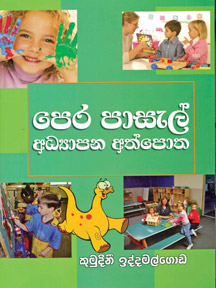Reading into preschool education

Once Margaret Mead, the well known anthropologist, pointed out in a
preface to ‘Children in Contemporary Cultures’, the function of teacher
in preschool education or children is one of the most important and most
scientific formative stages. Mead collected the functions of the teacher
in formulating teaching methods traditionally held and passed down the
years in various cultures.
Quite a number of books have been written on the subject of preschool
education. But the subject area leads to quite a number of new
innovations and trends in the field of preschool education. The
experimentations in the field of preschool education shows the extent to
which teachers are trained to safeguard the formative stages of a
child’s education path before entering the proper school level of
education.
Kumuduni Iddamalgoda has brought out an illustrative book that would
find a significant place in this area under discussion. The book is
titled as Pera Pasal Adhyapana Atpotha (a handbook of preschool
education, Sarasavi 2011), and contains seven short chapters
illustrating several basic communication skills that could be of good
guidance to a teacher.
The two-page short preface underlines the intention of the writer
Iddamalgoda. She believes that the education of a child begins even
before the actual birth of a child or when it is in the mother’s womb.
When a child sees the light of the day it prepares to learn certain
skills which could be termed broadly as communication skills. The little
toddler perceives certain learning in its environment. The parents may
not know how, what and where the little child begins to learn.
 But when the child gradually enters a particular group of similar
aged children, training may be needed. This training is perhaps passed
on to certain skilled and especially trained teachers who are termed as
preschool teachers. They play several roles inclusive of the role of the
mother and caretaker. This calibre of teacher cannot be underestimated
as their function is the foremost guidance required by a child. But when the child gradually enters a particular group of similar
aged children, training may be needed. This training is perhaps passed
on to certain skilled and especially trained teachers who are termed as
preschool teachers. They play several roles inclusive of the role of the
mother and caretaker. This calibre of teacher cannot be underestimated
as their function is the foremost guidance required by a child.
This book begins with a keen sense of a child’s scribbling process,
which has to be watched and noted as a serious way of a child
performance. The writer cum teacher trainer Iddamalgoda carefully notes
with examples, the hidden sense of dots, and scribbling and how the same
could be extended to evoke a gradual sense of creativity. Then comes the
observations on lines and how they could be termed as line patterns, zig
zag lines and wavy lines.
The drawings seen in the pages fused with interpretations may help
the teacher (as well as the trainer of teachers) to enter the contents
of each chapter. How a child could be helped to train develop
creativities is explained in chapter two and three.
These two chapters illustrate how the concepts of spiral lines,
concentric forms, could be extended to commence lessons on how to draw
pictures f objects around the child, using his/her own imagination. This
is followed by the concepts beginning writing kills, which may be an
area which could have been further illustrated. But this handbook is
meant to be guidance, I presume, for teacher trainers. Picture drawing
skills is the subject matter explained in chapter three. The child is
trained to create pictures without any additional help of equipment.
This includes known and unknown areas pertaining to college systems
of creativity. The creatures like tortoises, trees and fruits could be
made out of paper which will be a sort of creative game for the child.
Iddamalgoda underlines that the world of the child could be understood
for its performance via picture lessons.
This liberal tendency which is culture-bound has to be given much
thought in education. I hear that some adults complain about their
bitter childhood due to the lack of good teachers in preschool level.
Chapter five of the handbook (I am rather reluctant to use that term)
tries to clarify several new trends that could be utilized by using
shapes such as rounds or circles, squares, triangles, stars, crescents
and heart shapes. The teaching and perceiving shapes may go to the
extent of giving vent to new innovations like drawing pictures of huts,
rabbits, eggs and mice.
This in turn may be extended to the teaching of letters in the
alphabet. I found the gradual expansion of shapes into letters, quite
stimulating. I had no chance of learning them in my days.
Then in the last chapter the most eye opening type of contents are
enveloped. The creative games in a group as we know could lead to
problem-solving as well as laying foundation for better living. I am of
the view that our teachers should be able to rediscover various types of
creative games for not only for preschool level but also at all levels
of education. Iddamalgoda has a vision and a mission in the actual
designing of her work.
[email protected]
|



